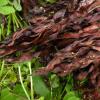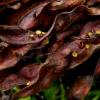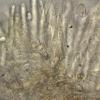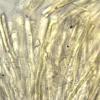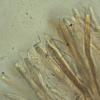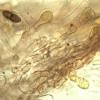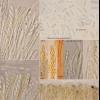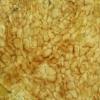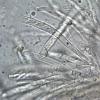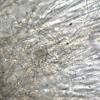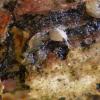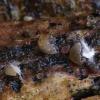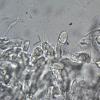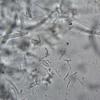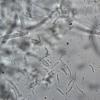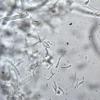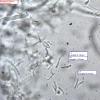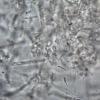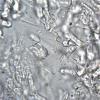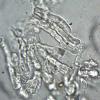
26-12-2025 21:19
Arnold BüschlenPithyella chalaudii Priou. Ist als Bryoparasit in

21-12-2025 09:32
Hello.A tiny ascomycete found embedded in wood in

18-12-2025 21:17
Pol DebaenstThe identification took me to Byssonectria deformi

24-12-2025 17:08
Hulda Caroline HolteHello, I have found this propoloid ascomycete on

21-12-2025 21:32
Pol DebaenstHello, Garden, Burgweg 19, Veurne, BelgiumOn 10/1

the bright yellow stipitate apothecia remind of a Sclerotiniaceae - the euamyloid ascusporus could confirm this.
The ectal excipulum of brownish cells have swollen end-cells with bright yellow vacuolor content - as have the parapyhses. The spores are about 9,5-12/4-5 µm and ciboriod - a lot of asci were still unripe. I will try to find this again and make better macrofotos.
But - I think this is a very striking species somebody of you should know.
Who is it?
Best regards from Lothar

Bonjour Lothar,
Very interesting collection. It looks like a Moellerodiscus
Amitiés
Michel

Hello Michel,
thank you for your first opinion.
I do not clearly now how the boarder between Ciboria and Moellerodiscus (former Ciboriopsis) goes. If there ist one ...
Best regards from Lothar

I agree with Moellerodiscus, and do not remember a similar collection. maybe M. lentus could be compared. Important is to know the croziers. :-)
About the generic limits: we must also ask how heterogen Ciboria is. It seems to be very heterogen when relying on DNA. For instance, C. bulgarioides is closely related to Cenangium acuum, though I do not see much similarities, but not at all to C. amentacea, and I remember that other Ciborias go to further clades....
maybe Moellerodiscus is more homogen than Ciboria.
Zotto

Hello Zotto,
thank you very much for your opinion. First: sorry, in fact I did not look for the croziers. I have kept a small piece fresh and try to look again this evening.
I find the swollen end-cells of the excipulum with bright yellow vacuolor content very striking. Does M. lentus have such? I do not remember that at all.
Best regards from Lothar



But it is not a Moellerodiscus. In Moellerodiscus (cf. lentus complex) you will not see this kind of VBs, and never in the most external cells of the excipulum. Maybe only at the margin you will see some similar pigments but then much more weak.
Cheers,
Raúl

you are certainly the expert in this group. I agree that the VBs are paler in my M. lentus on Populus leaves HB 8809 from Ile de Re, it seems that the margin does not show there striking VB-refractivity, though it has chlorinaceous VBs in the paraphyses.
But you really think that the species on Eucalyptus should be placed in another genus than M. lentus? For me they look very very similar. Is DNA the reason for your opinion?
Zotto

Yes, I think it would be better placed in a different genus. Apart from the molecular divergence, I see these differences... In Moellerodiscus (cf lentus complex): presence of SCBs in paraphyses, different type of VBs (less refractive), the not so wide spores (but I admit this is quite variable character), and, for me the most important, the nearly always present hemiamyloid reaction of the excipular cells. So far, I only haven´t seen it in the Moellerodiscus cf lentus which grows on Fraxinus leaves and it was doubtful in the one on Ceratonia leaves (the one with croziers).
Raúl


Holst-Jensen, Vralstad & Schumacher in "Kohninia linnaeicola, a new genus and species of the Sclerotiniaceae pathogenic to Linnaea borealis" Mycologia, 96(1), 2004, pp. 135–142:
"Several new species belonging in the Sclerotiniaceae are yet to be described, but the uncertain delimitation of core genera is a problem. The genera Ciboria Fuckel and Ciborinia Whetzel in particular are polyphyletic (Holst-Jensen et al 1997b, 2002), as probably is the type genus Sclerotinia Fuckel (Holst- Jensen et al 1998). While several new species could be described and accommodated within these genera as currently delimited (Schumacher 2000), only few species would be included if the genera were restricted to monophyletic entities. Because we believe that classification should reflect evolutionary relationships, we now restrict ourselves from describing new taxa with affinity to Ciboria and Ciborinia sensu lato. However, new taxa of the Sclerotiniaceae can and should be described if they are characterized by distinctive features, are clearly distinguishable from other taxa of the family and in particular if phylogenetic evidence support a specific classification. This could be either by linking them to type species of genera or to well-characterized genera, e.g., Myriosclerotinia N.F. Buchw. (Holst-Jensen et al 1998). If new taxa are sufficiently distinctive, another possibility is to erect new genera to host the new taxa, but this should be supported by phylogenetic evidence to avoid creation of paraphyletic taxa."
Raúl

But I disagree when molecular workers believe that taxonomic entities must be monophyletic. Evolution may have taken this way, but it is not logical to confine generic or other level concepts to monophyly. When doing so we achieve a lot of entities with rather variable morphology, and no morpho-key will enable to identify a genus anymore.
Apart from this I believe that it is a matter of taste at which branching level we can speak of a genus.

Hello together,
today I had problems with the internet and so I can read only now.
First: I found no croziers when I again looked at the material. Now it ist dried.
Nicolas: exactly these cells I saw when I analysed the fresh, bright yellow discs.
Today, the apothecia were faded to ochraceous brown and - I did not find the swollen cells with the yellow pigment any more. They were collapsed to large extent.
When I found the yellow one two days ago, in the vicinity there were also brown apothecia (on Rubus and Eucalyptus) which likely were M. lentus s.l., too. I did not notice the swollen yellow cells there, too.
I agree more with Zotto: it should be all Moellerodiscus. But - what do I know?
Best regards to everybody from Lothar
P.S. Todayb I collected more fungi - basidiomycetes like Chaetocalathus craterellus and Pleuroflammula ragazziana, but also ascomycetes - at least one of them I will post afterwards.
@Zotto: I also found Orbilia rubella (at least I strongly think so) on an dead twig in 2 m height on a living Nerium oleander. I did not put it on the doerrex but dry it in the air - maybe you are interested in the sample?

I strongly hope you made pics of the Orbilia whem still fresh! O. rubella in the mediterranean? Impossible. I could imagine O. albovinosa which is known from Eucalyptus.
"M. eucalypti" has croziers so it would be a surprize if there are none.
Yes, VBs disappear when fruitbodies get older or dry... that's life.

Hi Zotto,
Orbilia is very minute, especially the spores, microscopically - I made few fotos but that is very unsatisfactory with my equipment and skills. I give them anyway ...
I also made macrofotos but they are not really very good, too (small fungus).
Surely it maybe something else than rubella - but I mean it is at least related.
I think I will send you the fungus when I am home.
Best regards from Lothar
P.S. I add a fotos of the ascusbasis of M. "lentus" from Acacia

Orbilia: Indeed, the spores look like rubella or phragmotricha! I measured them as 9-10 x 1.3-1.4 which fits indeed better rubella than phragmotricha. I will look at the hairs when you sent me the sample. Danke dir!!! Falls du die Funddaten parat hast kannst du sie mir schon per Mail schicken.

Hi Zotto,
of course you get the collection data. Openly spoken: by now I have them not complete myself. I have the GPS-data of the foto and from this I will reconstruct villages and relations to towns. Exact maps with names of the places are not available (for me) in this part of Europe :-)
I am happy that I was not too wrong with O. rubella.
I send you the collection when I am back home again.
Best regards from Lothar

try this for maps: http://geoportal.lneg.pt/geoportal/mapas/index.html?servico=CGP50k
Grüße
Martin

Hi Martin,
thank you very much - I will try this by time :-)
Best regards from Lothar
